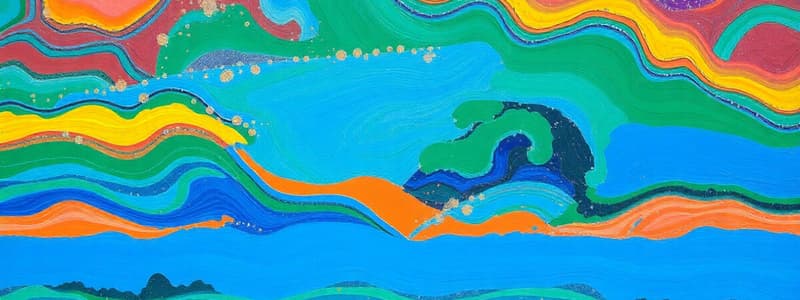Podcast
Questions and Answers
Which of the following is NOT an example of exogenic factors affecting the Earth's surface?
Which of the following is NOT an example of exogenic factors affecting the Earth's surface?
- Earthquakes (correct)
- Seawave action
- River works
- Wind activity
The hydrosphere covers 71% of the Earth's surface while the landmass covers 29%.
The hydrosphere covers 71% of the Earth's surface while the landmass covers 29%.
True (A)
What are the two main categories of factors that affect the Earth's surface?
What are the two main categories of factors that affect the Earth's surface?
Exogenic and endogenic factors
The process of _______ involves the movement of plates causing earthquakes and volcanic eruptions.
The process of _______ involves the movement of plates causing earthquakes and volcanic eruptions.
Match the following exogenic factors with their associated actions:
Match the following exogenic factors with their associated actions:
What primarily influences the erosional power of a river?
What primarily influences the erosional power of a river?
Bank erosion occurs when a river is flowing through a steep mountainous area.
Bank erosion occurs when a river is flowing through a steep mountainous area.
What is the term for the zigzag course a river takes when flowing over gentle slopes?
What is the term for the zigzag course a river takes when flowing over gentle slopes?
The type of lake shaped like a horse shoe created by a river's meandering is called a __________ lake.
The type of lake shaped like a horse shoe created by a river's meandering is called a __________ lake.
Match the river processes with their descriptions:
Match the river processes with their descriptions:
Flashcards
Exogenic factors
Exogenic factors
External forces that shape Earth's surface, like sun, wind, and water.
River work
River work
The processes that rivers use to change the land, including erosion and deposition.
Wind work
Wind work
How wind affects the land by eroding and depositing materials.
Glacier work
Glacier work
Signup and view all the flashcards
Sea-wave action
Sea-wave action
Signup and view all the flashcards
River Erosion
River Erosion
Signup and view all the flashcards
River Channel
River Channel
Signup and view all the flashcards
Lateral Erosion
Lateral Erosion
Signup and view all the flashcards
Meandering Course
Meandering Course
Signup and view all the flashcards
Cut-off Lake
Cut-off Lake
Signup and view all the flashcards
Study Notes
Introduction to Earth's Surface Change
- Earth's surface is composed of continents (29%) and oceans (71%)
- Features on land include plains, plateaus, hills, mountains, river valleys, deserts, and coastal plains
- Ocean features include submerged plateaus, plains, ridges, trenches, and coral reefs
- These features are a result of processes over long periods of time
- Some processes are exogenic (external forces), while others are endogenic (internal forces)
- Exogenic forces include sun, wind, rainfall, rivers, glaciers, and sea waves
- Endogenic forces include earthquakes and volcanic eruptions
- Plate tectonics is a major endogenic process, causing earthquakes and volcanic activity
Exogenic Factors of Earth's Surface Change
- Exogenic factors operate externally on the earth's surface
- The sun, wind, rain, rivers, glaciers, and sea waves are significant
- Influence varies spatially and temporally
- During ice ages (2 million years ago), glaciers covered extensive areas
- Future global climate change may result in significant glacier activity changes
River Work
- Rivers are significant external agents shaping the Earth's surface
- Rivers operate in tropical and subtropical regions
- River basins form from rivers and tributaries
- River activities include erosion, transportation, and deposition
- Erosion occurs as rivers flow downhill, eroding the surface
- Transportation involves moving materials like sediment via water current
- Deposition occurs as rivers slow, dropping sediments
Wind Work
- Wind is a significant external agent, especially in desert areas
- Wind erosion, transportation, and deposition create diverse features
- Deflation is wind blowing away sand and dust, creating depressions
- Deflation carries sand and dust to other areas
- Deposited material forms sand dunes of varying shapes and sizes
Glacier Work
- Glaciers are important in areas with extremely cold temperatures
- Glaciers include continental glaciers (ice sheets) and mountain/valley glaciers
- Glaciers move slowly down slopes
- Glacier erosion happens through ice movement and transported material
- Glaciers carve U-shaped valleys, forming sharp-peaked mountains
- Glaciers carry debris which can form moraines (types include lateral moraines, ground moraines, medial moraines, and terminal moraines)
Sea-Wave Action
- Oceans cover 71% of the world
- Coastline is the boundary between land and ocean
- Waves erode coasts
- Deposition can form beaches, which are made up of sand or pebbles
- Earthquakes can cause tsunamis (devastating waves)
Studying That Suits You
Use AI to generate personalized quizzes and flashcards to suit your learning preferences.



